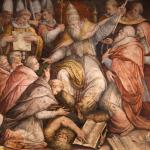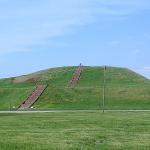Jesus charges the Laodicean angel with being lukewarm, neither hot nor cold (Revelation 3). This is understandably and rightly taken as a symbol of their indecisiveness and lethargic piety.
But there’s a whole lot more going on.
Hot and cold match day and night (Genesis 8:22). “Heat of the day” is a common expression, and the night is the time of cold (Job 24:7). The Laodiceans have come to the light, into the heat of the day. But they are uncomfortable in the daytime. Standing in the day, they long for the night, and end up in a vulnerable place between. They are like the multitudes who come from Egypt but long for the garlic and veggies of old.
I think we can stick Greek science in here without much trouble, with a Hebraic/New Testament twist. “Cold” and “hot,” with
“dry” and “moist” were the four main qualities of matter according to Greek
physics. These four in their different
combinations formed the four elements. Fire
is hot and dry, air is hot and wet, water is wet and cold, and earth is dry and
cold. These combinations formed atoms in different shapes, which made different
sorts of combinations that made the material things of the universe. There was a micro/macros relationship; the
four elements matched four humors – yellow bile was fiery, black bile earthy,
blood airy, and phlegm watery.
These combinations are brought into the biblical
world through a series of puns. The word
for cold is psuchros, used here only in the New
Testament. A synonym, psuchos, is used in several passages:
John 18:18 (Peter warming himself by fire on a cold night); Acts 28:2 (Paul starting fire
because it is cold); 2 Corinthians 11:27 (Paul describing the exposure of
apostolic ministry – to cold and nakedness).
What is intriguing, though, is that each of these terms is punningly
connected with the Greek words for “soul” and “soulish” (or natural). psuchichos means “having breath” or
“natural,‘‘ and is used by Paul to describe the character of the first man. Adam is created from the ground and has
“breath” from God, but He is not yet Spiritual, filled with the Spirit of
God. Jesus is the Last Man, the man from
heaven, who has the Spirit and not merely breathiness (1 Corinthians 2:14;
15:44, 46; cf. James 3:15; Jude 19).
Adam is created soulish, and the word puns with “cold,”
which is a characteristic of earth. But
when Eve was brought to Adam, he became ‘ish, a pun on ‘esh, “fire.”
Adam went from earth to fire, from cold to hot, when Eve was brought to
Him, a foreshadowing of the greater transformation that comes when the Last Adam arrives, filled with the fire of Yahweh’s love, with His Bride. Adam becomes ‘ish, but Jesus is the first real Fire-man.
This is the trajectory of humanity,
moving from soulish/cold to Spiritual/hot, from night to day.
The first covenant was a cold one, the second a hot covenant; the first is coldly earthy, the second hotly heavenly. But the
Laodiceans are hesitating between these options. They want to remain on the fence, lukewarm, crepuscular.















